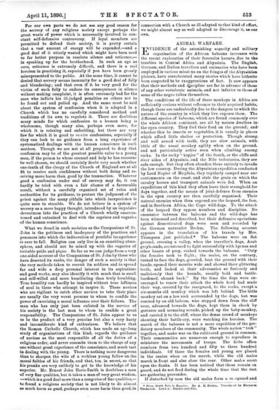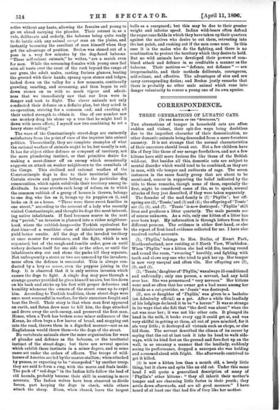ANIMAL WARFARE.
EVIDENCE of the astonishing sagacity and military organisation of the African baboons increases with the recent exploration of their favourite haunts, due to the
troubles in Central Africa and Abyssinia. The English, German, and Italian travellers and emissaries who have been The conditions of the life of these monkeys in Africa are sufficiently curious without reference to their acquired habits,
though these are undoubtedly due to the dangers to which the nature of the country in which they live exposes them. The different species of baboons, which are found commonly over the whole African continent, are all by nature dwellers in, the open country. They find their food on the ground; and' whether this be insects or vegetables, it is usually in places which afford little shelter or protection. Though strong. and well armed with teeth, they are slow animals, with little of the usual monkey agility when on the ground, and not particularly active even when climbing among. rocks. In the rocky " kopjes " of the South, or the cliffs anti.
river sides of Abyssinia, and the Nile tributaries, they are safe enough. But they often abandon these entirely to invade the low country. During the Abyssinian expedition conducted' by Lord Napier of Ma gdala, they regularly camped near our cantonments on the coast, and stole the grain on which the cavalry horses and transport animals were fed. When on expeditions of this kind they often leave their stronghold for days together, and the means of joint-defence from enemies in the open country are then carefully organised. Their natural enemies when thus exposed are the leopard, the lion, and in Southern Africa, the Cape wild-dogs. To the attack of the leopard they oppose numbers and discipline. No encounter between the baboons and the wild-dogs has been witnessed and described, but their defensive operations against domesticated dogs were seen and recorded by the German naturalist Brehm. The following account appears in the translation of his travels by Mrs.
Thompson just published.* The baboons were on flat ground, crossing a valley, when the traveller's doge, Arab greyhounds, accustomed to fight successfully with hyenas and other beasts of prey, rushed towards the baboons. "Only the females took to flight ; the males, on the contrary, turned to face the dogs, growled, beat the ground with their hands, opened their months wide and showed their glittering teeth, and looked at their adversaries so furiously and maliciously that the hounds, usually bold and battle-
hardened, shrank back." By the time the dogs were en-
couraged to renew their attack the whole herd had made their way, covered by the rearguard, to the rocks, except a six-months old monkey which was left behind. The little
monkey sat on a low rock surrounded by the doge, but was rescued by an old baboon, who stepped down from the cliff near, advanced towards the dogs, kept them in check by gestures and menacing sounds, picked up the baby-monkey, and carried it to the cliff, where the dense crowd of monkeys shouting their battle-cry, were watching his heroism. The march of the baboons is not a mere expedition of the pre- datory members of the community. The whole nation" trek" together, and make war on the cultivated ground in common. Their communities are numerous enough to reproduce in miniature the movements of troops. The tribe often numbers from two hundred and fifty to three hundred individuals. Of these the females and young are placed in the centre when on the march, while the old males march in front and also close the rear. Other males scout upon the flanks. It has been noticed that these remain on guard, and do not feed during the whole time that the rest are gathering provender.
If disturbed by men the old males form a re.,rguard and • From North Polo to Ertotor. By A. B. Brehm. Tramds'ed by Margaret nom; eon. Lend : Mackie and Soo. retire without any haste, allowing the females and young to go on ahead carrying the plunder. Their retreat is, as a rule, delibei ate and orderly, the baboons being quite ready to do battle with any animal except man on the plains, and instantly becoming the assailant of man himself when they get the advantage of position. Brehm was stoned out of a pass in a very few minutes by the dog-faced baboons. "These self-reliant animals," he writes, "are a match even for men. While the screaming females with young ones fled with all haste over the crest of the rock beyond the range of our guns, the adult males, casting furious glances, beating the ground with their hands, sprang upon stones and ledges, looked down on the valley for a few moments, continually growling, snarling, and screaming, and then began to roll down stones on us with so much vigour and adroit- ness that we immediately saw that our lives were in danger and took to flight. The clever animals not only conducted their defence on a definite plan, but they acted in co-operation, striving for a common end, and exerting all their united strength to obtain it. One of our number saw one monkey drag his stone up a tree that he might hurl it down with more effect; I myself saw two combining to set a heavy stone rolling."
The wars of the Constantinople street-dogs are eminently satisfactory from the point of view of the inquirer into animal politics. Theoretically, they are complete examples of what the rational warfare of animals ought to be, but usually is not. It has for object either defence or conquest of territory, not the mere plundering instinct, or that primitive desire for making a meat-dinner off an enemy which occasionally suggests an attack on weaker neighbours to the cannibals of the Congo. This civilised and rational warfare of the Constantinople dogs is due to their territorial instinct. Certain streets and quarters belong to the particular dog communities, which again subdivide their territory among in- dividuals. In some streets each heap of refuse, on to which the common rubbish of a group of houses is thrown, belongs to one dog, who lies on it, brings up its puppies on it, and looks on it as a home. "There were three sweet families in one street," according to the account of a lady who recently visited Constantinople, and thought its dogs the most interest. ing native inhabitants. If food becomes scarce in the next dog "parish," an invasion is planned into a richer neighbour- hood, where the rubbish-heaps—the Turkish equivalent for dust-bins—of a wealthier class of inhabitants promise to yield better results. All the dogs of the invaded territory at once muster for resistance, and the fight, which is not organised, but of the rough.and-tumble order, goes on until victory declares itself for one side or the other, or until the inhabitants step out and stone the packs till they separate. Not I:infrequently a street or two are annexed by the invaders; more often the defence is successful. This is always con- dacted by a levy en masse, even the puppies joining in the fray. It is observed that it is only serious invasion which causes the dogs to fight. A single dog may pass through a strange quarter provided he gives himself no airs, but lies down on his back and sticks up his feet with proper deference and humility whenever the owners of the street come up to expel him. According to Turkish tradition, these street-dogs were once most successful in warfare, for their ancestors fought and beat the Devil. Their story is that when man first appeared on earth, and Satan drew near to kill him, the dogs attacked and drove away the arch-enemy, and preserved the first man. Hence, when a Turk has broken some minor ordinance of the Koran, he often buys a few loaves of bread, and stepping out into the road, throws them in a dignified manner—not as an Englishman would throw them—to the dogs of the street. No vertebrate animals show the same organisation for wars of plunder and defence as the baboons, or the territorial instinct of the street-dogs; but there are several species which exhibit these instincts in a minor degree, and in some cases act under the orders of officers. The troops of wild- horses of America are led by the master-stallion; when attacked by pumas, or expecting to be " stampeded " by another troop, they are said to form a ring, with the mares and foals inside. The pack of " red-dogs " in the Indian bills follow the lead of old hounds, probably because their skill in scenting is more accurate. The Indian wolves have been observed to divide forces, part keeping the dogs in check, while others attack the sheep. Bison, when chased, leave the largest
bulls as a rearguard; but this may be due to their greater weight and inferior speed. Indian wild-boars often defend the sugar-cane fields in which they have taken up their quarters against the natives who desire to cut them, retreating into the last patch, and rushing out if the men come near. In this case it is the males who do the fighting, and there is no combination to protect the territory which they desire to hold. But no wild animals have developed their powers of com- bined attack and defence in so creditable a manner as the baboons. Their motives — "defence, not defiance" — are irreproachable, and their methods deliberate, courageous, self-reliant, and effective. The advantages of size and sex carry corresponding duties; and Brehm justly remarks that there is probably no other male animal which runs into. danger voluntarily to rescue a young one of its own species.



































 Previous page
Previous page